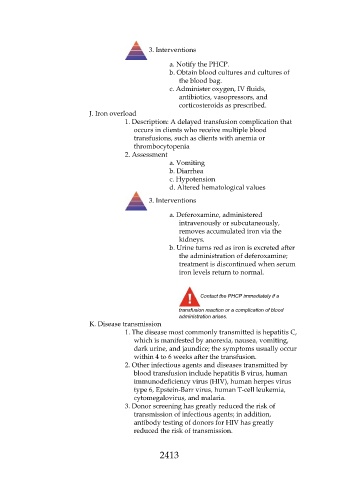Page 2413 - Saunders Comprehensive Review For NCLEX-RN
P. 2413
3. Interventions
a. Notify the PHCP.
b. Obtain blood cultures and cultures of
the blood bag.
c. Administer oxygen, IV fluids,
antibiotics, vasopressors, and
corticosteroids as prescribed.
J. Iron overload
1. Description: A delayed transfusion complication that
occurs in clients who receive multiple blood
transfusions, such as clients with anemia or
thrombocytopenia
2. Assessment
a. Vomiting
b. Diarrhea
c. Hypotension
d. Altered hematological values
3. Interventions
a. Deferoxamine, administered
intravenously or subcutaneously,
removes accumulated iron via the
kidneys.
b. Urine turns red as iron is excreted after
the administration of deferoxamine;
treatment is discontinued when serum
iron levels return to normal.
Contact the PHCP immediately if a
transfusion reaction or a complication of blood
administration arises.
K. Disease transmission
1. The disease most commonly transmitted is hepatitis C,
which is manifested by anorexia, nausea, vomiting,
dark urine, and jaundice; the symptoms usually occur
within 4 to 6 weeks after the transfusion.
2. Other infectious agents and diseases transmitted by
blood transfusion include hepatitis B virus, human
immunodeficiency virus (HIV), human herpes virus
type 6, Epstein-Barr virus, human T-cell leukemia,
cytomegalovirus, and malaria.
3. Donor screening has greatly reduced the risk of
transmission of infectious agents; in addition,
antibody testing of donors for HIV has greatly
reduced the risk of transmission.
2413

